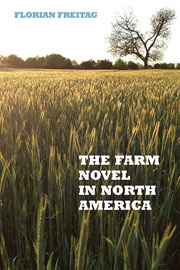 The Farm Novel in North America
The Farm Novel in North America Book contents
- Frontmatter
- Contents
- Acknowledgments
- Introduction
- 1 Surveying the Fields
- 2 Early Sowings: St. John de Crèvecocur's “History of Andrew, the Hebridean,” Patrice Lacombe's La terre paternelle, and Susanna Moodie's Roughing It in the Bush
- 3 Laws of Nature: Frank Norris's The Octopus, Albert Laberge's La Scouine, and Frederick Philip Grove's Settlers of the Marsh
- 4 New World Demeters: Willa Cather's O Pioneers!, Louis Hémon's Maria Chapdelaine, and Martha Ostenso's Wild Geese
- 5 Rich Harvests: Joseph Kirkland's Zury: The Meanest Man in Spring County, Claude-Henri Grignon's Un homme et son péché, and Frederick Philp Grove's Fruits of the Earth
- 6 Fields of Crisis: John Steinbeck's The Grapes of Wrath, Félix-Antoine Savard's Menaud, maître-draveur, and Robert J. C. Stead's Grain
- 7 The Cycle of Seasons: Louis Bromfield's The Farm, Ringuet's Trente arpents, and Grace Campbell's The Higher Hill
- Epilogue
- Works Cited
- Index
2 - Early Sowings: St. John de Crèvecocur's “History of Andrew, the Hebridean,” Patrice Lacombe's La terre paternelle, and Susanna Moodie's Roughing It in the Bush
Published online by Cambridge University Press: 05 December 2013
- Frontmatter
- Contents
- Acknowledgments
- Introduction
- 1 Surveying the Fields
- 2 Early Sowings: St. John de Crèvecocur's “History of Andrew, the Hebridean,” Patrice Lacombe's La terre paternelle, and Susanna Moodie's Roughing It in the Bush
- 3 Laws of Nature: Frank Norris's The Octopus, Albert Laberge's La Scouine, and Frederick Philip Grove's Settlers of the Marsh
- 4 New World Demeters: Willa Cather's O Pioneers!, Louis Hémon's Maria Chapdelaine, and Martha Ostenso's Wild Geese
- 5 Rich Harvests: Joseph Kirkland's Zury: The Meanest Man in Spring County, Claude-Henri Grignon's Un homme et son péché, and Frederick Philp Grove's Fruits of the Earth
- 6 Fields of Crisis: John Steinbeck's The Grapes of Wrath, Félix-Antoine Savard's Menaud, maître-draveur, and Robert J. C. Stead's Grain
- 7 The Cycle of Seasons: Louis Bromfield's The Farm, Ringuet's Trente arpents, and Grace Campbell's The Higher Hill
- Epilogue
- Works Cited
- Index
Summary
During the first half of the nineteenth century North American prose fiction and life writing increasingly focused on the farm. Starting in the 1820s, a growing number of novels, collections of sketches, travclogues, settlers' accounts, and journals from the United States, English Canada, and French Canada dealt with farm life. Among the authors of these texts were professional writers such as James Fenimore Cooper and Nathaniel Hawthorne; the domestic fictionists of the middle of the nineteenth century; practitioners of the liberal professions and politicians who wrote in their spare time, such as Patrice Lacombe, Pierre-Joseph-Olivier Chaveau, and Antoine Gérin-Lajoie; travelers to regions that were in the process of being agriculturally settled such as Margaret Fuller; absentee or present landowners such as Mary Austin Holley or Caroline M. Kirkland; and actual settlers and farmers such as Mary O'Brien, Catharine Parr Traill, and Susanna Moodie.
These writers depicted farm life in North America in a large variety of ways, from pastoral, fulfilling, and idealistic to dreary, disenchanting, and iconoclastic. Only very few of these texts, however, raise issues of the nation in connection with their focus on farm life and thus anticipate the way farms, farmers, and farming would later be portrayed in the North American farm novel, especially in the French Canadian roman de la terre. More specifically, while they feature certain elements that would also characterize later American, English Canadian, and French Canadian farm novels, most of these texts combine these elements in ways that make it yet impossible to identify distinctly national traditions in the portrayal of the farm.
- Type
- Chapter
- Information
- The Farm Novel in North AmericaGenre and Nation in the United States, English Canada, and French Canada, 1845-1945, pp. 65 - 105Publisher: Boydell & BrewerPrint publication year: 2013
